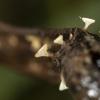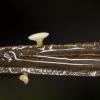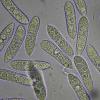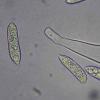
15-11-2025 23:22
Mario FilippaHello,this is what I think to be Hymenoscyphus mac

14-11-2025 16:26
 Marian Jagers
Marian Jagers
Hello everyone, On dead wood of Cytisus scoparius

15-11-2025 20:25
 Riet van Oosten
Riet van Oosten
Hello, Found by Laurens van der Linde, Nov. 2025

14-11-2025 18:31
 Lothar Krieglsteiner
Lothar Krieglsteiner
Hello,can somebody provide me with a file of:Rothe

12-11-2025 09:25
 Viktorie Halasu
Viktorie Halasu
Hello, I need help with a pale terrestric Pseudom

11-11-2025 20:16
Bohan JiaHi, lastly I have found these tiny yellow decayin

09-11-2025 13:20
Hello.A tiny ascomycete, appearing as erupting gra
Lanzia equiseti?
Johan Myhrer,
22-08-2018 17:52
Found these on dead stems of Equisetum fluviatilis standing in water near a slow stream in central Sweden yesterday. Hymenoscyphus seemed probable but the spores where large and "weird".
Spores: (29-)30(-32)x(6-)7,5µm
Asci ~130-150µm
Most things are very similar to Marja Pennanens collection from 2010 (http://www.ascofrance.com/search_forum/12546). Can anyone confirm the species, seems to be first collection for Sweden.
Lothar Krieglsteiner,
22-08-2018 18:46

Re : Lanzia equiseti?
Hello Johan,
I do not know what "Lanzia" equiseti is - but your collection looks like a member of the Hymenoscyphus caudatus-complex to me.
Best regards, Lothar
Johan Myhrer,
22-08-2018 20:19
Re : Lanzia equiseti?
There is a "Hymenoscyphus" equiseti, described by Raitviir 1984 as Lanzia equiseti.
François Valade,
22-08-2018 20:34

Re : Lanzia equiseti?
Lothar, look at Hymenoscyphus folder in Zotto's Drive.
Hans-Otto Baral,
22-08-2018 20:38

Re : Lanzia equiseti?
I confirm L. equiseti which has a Hymenoscyphus-type of apical ring, so cannot belong in Lanzia. The spores of this species are not really scutuloid, although those of H. caudatus are also only slightly so. They have an extraordinary size, in any case.
A sequence of an isotype of L. equiseti from Karelia gained by Kadri Pärtel showed that this is a Helotiaceae but not a Hymenoscyphus in the narrow sense. So a very interesting matter.
Zotto
PS. I must correct myself, the spores are indeed slightly to distinctly scutuloid here, while in the type and Marja's sample they are only very indistinctly so.
A sequence of an isotype of L. equiseti from Karelia gained by Kadri Pärtel showed that this is a Helotiaceae but not a Hymenoscyphus in the narrow sense. So a very interesting matter.
Zotto
PS. I must correct myself, the spores are indeed slightly to distinctly scutuloid here, while in the type and Marja's sample they are only very indistinctly so.
Hans-Otto Baral,
03-04-2020 10:34

Re : Lanzia equiseti?
Dear Johan
I am preparing a description of H. equiseti, and I wonder if you have more photos. Especially a mature ascus (you posted only the ascus base).
Important would be to include a scale to your photos. I also wonder about apothecial size and stipe length, data necessary in a description.
Danny Haelewaters obtained a sequence, and we want to prepare a small contribution within a joint larger publication of various authors.
Zotto





